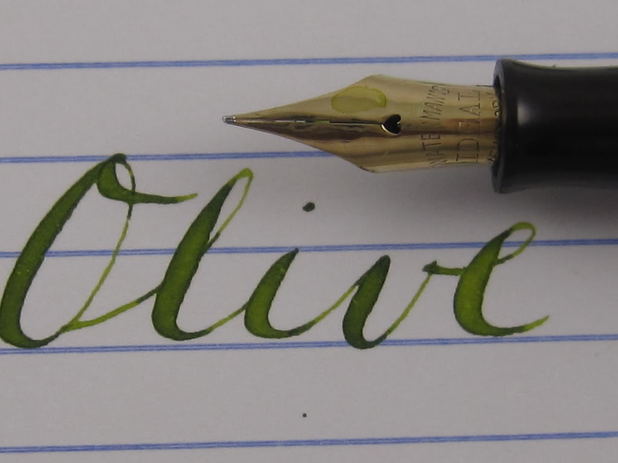Recommendations on pens for pointed/expanding pen calligraphy?

Alexis Samson
Posts: 11
I discovered there are some very nice guides here for pointed pen calligraphy. I'm trying to find pens to use to practise but I'm not sure what the correct pens are, when I look up calligraphy pens, I find 'fountain pens':

Doing more research I find that actually they're referred to as 'flex nib' which look kind of the same to me:

Are these what is referred to as pointed pen? I'd love to hear about your recommendations and experience on the pens to use for pointed pen calligraphy. (Also are Speedball are brand of flex nib or a type in itself?)

Doing more research I find that actually they're referred to as 'flex nib' which look kind of the same to me:

Are these what is referred to as pointed pen? I'd love to hear about your recommendations and experience on the pens to use for pointed pen calligraphy. (Also are Speedball are brand of flex nib or a type in itself?)
Tagged:
0
Comments
-
What's your budget?
dip pens have the most flex and will be the least expensive, but they can be trickier and, of course, you have to keep dipping them in the ink bottle. If there is any part of you that is messy, it will get messy.
http://www.paperpenalia.com/flex2.html. What I know about Speedball is that they mostly focus on broad nib pens. you'll find a good selection of pointed nibs at most art supply stores. The off-set nib holders may be a little harder to find.
One thing to know about writing with a flex nib is that they are delicate. You get the flex on the down stroke. trying it on the up stroke will spatter ink, tear and/or tear the paper with a dip pen and could ruin the nib of a (flex nib) fountain pen. I believe the main advantage to the off-set nib holder is that it lets you get maximum flex for spencerian script without turning the page so much to the get the correct angle relative to your body. I prefer fountain pens, so don't quote me.
The very best flex fountain pens are some of the vintage ones, like the Waterman's in the photo. From about the start of the 1900s, I guess it was expected that a good fen would have some flex, but that seemed to change after the forties. Maybe sooner. People stated to need to sign documents in triplicate so nibs got stiffer. Maybe. I'm not a pen historian. Then people started to loose the skill required to not ruin a flexible nib as ball point pens became more popular. You can get some good flexible ones on Ebay, but you're taking a chance until you have some experience and spot a good pen. Better to go to a dealer. Heres a good one: http://gregminuskin.com/
There are some passable and some very good modern ones now too.
Noodlers, for the price are pretty good http://www.gouletpens.com/Noodler-s-Ahab-Flex-Pens/c/140
At the other end of the scale is the Pilot/Namiki Falcon. (awesome pen) http://www.gouletpens.com/PN-Falcon-BlackRhod/p/PN-Falcon-BlackRhod
If wanted to you go off the deep end with pens, you can always get a custom ground nib for added flex.2 -
The best inexpensive flex nib pens are the Noodler's series. They run 14-25 on Amazon. Titanio is an Italian line of titanium nib pens that flex like vintage full flex gold. They start at around $300 and are hard to find. Vintage pens with gold nibs go for between $100 and $10,000, can be a PITA to use, and are sold mostly on eBay.
I prefer the Noodler's Pens because I can destroy them with my big heavy hand and not care. $30 a year for a pen and ink is a lot cheaper than markers.
If you meet Laura Worthington at a convention ask to see her vintage pens. She has some amazing wet noodle nibs and knows how to use them.2 -
Thank you James for taking the time to write back extensively! I am just starting out and so am going to begin with the cheaper end equipment, get a bit of practise before I move onto the really costly (and delicate?) equipment.
dip pens have the most flex and will be the least expensive
Why are dip pens so flexible? Is it because the nib material can be softer when it does not have to have an ink holder in the pen?I believe the main advantage to the off-set nib holder is that it lets you get maximum flex for spencerian script without turning the page so much to the get the correct angle relative to your body.
I didn't know about offset pens! For roman calligraphy like in the Typedrawers thread, would it be fine to use 'normal' pens?
0 -
Your link broke, Alexis. Which thread were you trying to mention?0
-
Dip pens are more flexible than fountain pens because they're not as durable. The advantage being that you can just beat them up and replace them. Replacing the nib on a fountain pen is more complex, and not something you want to deal with when working, so they're much sturdier.0
-
Alexis, there are a ton of options to consider. Do you want dip or fountain. There is a profound difference unless you have someone "shave the fountain pen for more flexibility (Greg Minuskin in LA)." It also depends on the style you intend to write… "Spencerian or Copperplate." There are a number of practitioners here in the states and abroad who have varying opinions on what the best nib is. So, my recommendation is take a class or two and talk to as many people as you can. I've no clue where you reside so in America there is Michael Sull, Pat Blair and in Canada there is Heather Victoria Held. In England there is Rachel Yallop. A few people have passed in the last years both here and abroad. As far as nib "holder" makers there is Christopher Yoke, great quality but pricey.
This should at least get you started.
1 -
Just as an aside: For a long time I've used almost exclusively for day to day writing, two fountain pens. A Parker 51 and a Sheaffer touch down with a triumph nib, both made in the '40s. Neither is flexible.
My wife introduced me to the concept of flexible nibs recently, with the result that my interest has escalated to the point where I currently have close to fifty fountain pens, mostly really old and with some degree of flex. Mostly from the 1940's or older. I've learned how to repair them them and have brought dozens of sorry looking specimens from literal pieces of junk to - not necessarily pristine writing instruments that would fetch multi-dinaro on Ebay, but beautifuly functional writing instruments - providing all you care about is the nib and ink delivery system.
1 -
@Russell_McGorman
Where did you learn to repair them? Sounds like a good project!0 -
It is a great project if you don't mind walking around with blue fingers

I'm a fiddler at heart. Taking things apart comes naturally to me -- Eventually I had to learn to put them back together. Things used to be made so that they could be fixed. Once upon a time, you would actually take your pen into the shop for repairs if it was giving you trouble.
There are old repair manuals on line, people are still manufacturing the latex ink sacs, You can get "new old stock" parts.
Take a look at the Fountain pen network: http://www.fountainpennetwork.com/forum/
there are there are all kinds of YouTube videos.
also check out this site, http://dirck.delint.ca/beta/ Lots of pen history and technical info.
1 -
I would recommend learning with an actual dip nib as opposed to a flexible fountain pen. If you pay the big bucks for a really good one or reworked one you can get relatively OK thicks and thins, but none will have the fineness and flexibility of a good quality dip nib. The one site that has the most info on pointed pen lettering along with lessons and advice is: http://www.iampeth.com.2
-
-
Instagram has a great community of calligraphers who love to talk nibs, pen holders, and ink. I love vintage nibs, but I try to stick to new ones so I don't get dependent on something rare.
Paper Ink Arts wrote a great blog post about the sampler set they sell. They had a few popular calligraphers review them:
http://paperinkartsblog.com/2015/04/01/the-copperplate-sampler-nib-by-nib/
3 -
I second the recommendation for the Brause 66 (for myself) but I also like the Brause 361 Steno as my (super beginner) students seem to be able to cope with this one easiest. It is pretty hard, meaning, you have to put quite a lot of pressure on it to get thick strokes, but it also remains thin by itself on upstrokes, good distribution of ink, and it is more or less indestructible. Also very widely available here in not so specialized shops, going for ca. €0,50–0,80 a nib.1
Categories
- All Categories
- 46 Introductions
- 3.9K Typeface Design
- 487 Type Design Critiques
- 564 Type Design Software
- 1.1K Type Design Technique & Theory
- 656 Type Business
- 861 Font Technology
- 29 Punchcutting
- 520 Typography
- 119 Type Education
- 324 Type History
- 77 Type Resources
- 112 Lettering and Calligraphy
- 33 Lettering Critiques
- 79 Lettering Technique & Theory
- 559 Announcements
- 94 Events
- 114 Job Postings
- 170 Type Releases
- 180 Miscellaneous News
- 276 About TypeDrawers
- 54 TypeDrawers Announcements
- 120 Suggestions and Bug Reports





